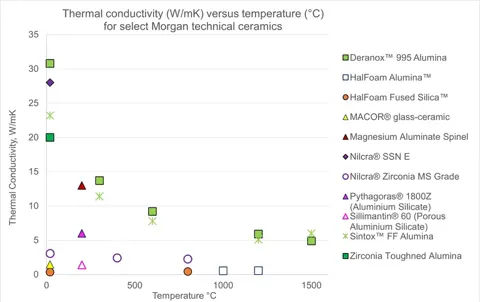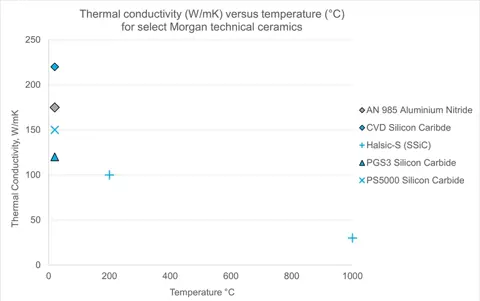Technical Ceramics

Thermal Conductivity
Thermal conductivity (λ) is defined as the amount of heat that passes through the surface of the material, in a perpendicular direction to the surface, per a unit of time.
Contact usThe heat transfer is measured under a steady-state temperature gradient. The unit of measure is typically Watts per Meter per degree Kelvin (W/m*K) or British Thermal Units per hour per foot per degree Fahrenheit (BTU/hr*ft*F).
A material with a low thermal conductivity value will be more heat insulative versus a material with a high thermal conductivity value. For example, the λ of alumina is about 6.3 W/(m*K) versus the λ of aluminium is about 230 W/(m*K).
Temperature Range
Like many properties, for context or comparison purposes, it is important to indicate the temperature range at which the value was measured.
Ceramics offer a wide range of conductivities. For example, synthetic diamond is more thermally conductive than copper alloys, while zirconia, fused silica, and glass ceramics have thermal conductivities near concrete. Low thermal conductivity in ceramics is often further reduced by introducing controlled amount of porosity volume into the ceramic article.

Electrical Insulators
Despite ceramics being generally known and specified as thermal insulators, certain ceramics, such as aluminium nitride, are specified as electrically insulative thermal conductors (or heat spreaders) due to their relatively high thermal conductivities versus other electrical insulators.

Thermal Diffusivity
Thermal diffusivity (a) is thermal conductivity (λ) divided by the specific heat capacity and the density (ρ) of the ceramic at constant pressure. The unit of measure is typically square meters per second (m2/s).
Whereas thermal conductivity indicates how much heat will flow through the surface of a material, thermal diffusivity indicates how fast the heat will flow within the material. Therefore, a material with a high thermal diffusivity will heat or cool more quickly than a material with a low thermal diffusivity value.
Like thermal conductivity, thermal diffusivity also varies with temperature. For most ceramics, thermal diffusivity generally decreases as temperature increases, meaning the rate of cooling will slow at increased temperatures. This attribute is a consideration when designing ceramic heaters.



